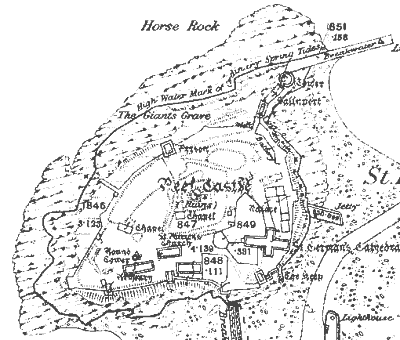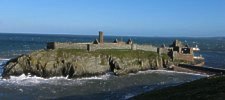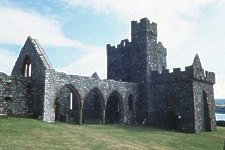
From 1868 O/S Plan

From 1868 O/S Plan
This small islet, now joined to Peel Hill by an artifical causeway contains the ruins of the old St German's cathedral, Bishop's Palace, Round Tower and St Patrick's Chapel as well as various military ruins.
The Breakwater shown above is the 1860 Abernethy breakwater which was originally formed of a stout creosoted timber superstructure upon a sloping foundation of loose rubble - however the destruction of the partially built Douglas Breakwater indicated the need for it to be cased with concrete blocks and otherwise strengthened - it was considerably lengthened in the 1890's.
The jetty dates from around 1830 whilst the breakwater connecting the Island to Peel Hill dates from the 1730's and was part of the improvements to Peel Harbour initiated by George Moore to facilitate the running trade - previous to this the Island was only accessible on foot or horseback at low tide.

St Patrick's Isle viewed from Peel Hill
The island is formed of slate with a ridge running east-west upon which stands the Round tower and St Patrick's Church; to north and south the land falls in a NW-SE manner though with irregular terraces on the south.
.
A small rectangular chapel - St Patrick's Keeil stands some 25m to the north with some late medieval masonry set into older work.
The oldest extant buildings are the Round tower and the adjacent St Patrick's Church - these share the same axis and, though now hemmed in, would have been dominant structures sited on the ridge. The tower is some 15m tall, the battlements are late medieval but their addition did not alter the height. It is built from irregular blocks of sandstone- the quarry probably being across Peel Bay at Creg Malin. Irish towers, or belfries, were constructed from the 9th century but were still being built in the 12th - the absence of detail makes dating difficult.
The adjacent church has been modified at least twice - the original church of which the surviving masonry forms the bottom level of the north and south walls measured some 8.4m by 5.5m but with the side walls projecting as antae beyond the gable line. A door would have been in the centre of the west gable immediately opposite to the round tower. Radford describes this complex of tower and church as typically Irish and associated with the larger monestaries in Ireland - he dates it from 900 to 1050 but probably nearer the beginning or middle than the end of this period.
Sometime later the Church appears to have suffered a disaster in that the side walls were reduced to some 2 feet (0.6m) and rebuilt together with an extended west end - the repair work was done using herring-bone masonry, an English technique hardly used elsewhere on Mann. Radford suggests that this was done by English masons imported by Olaf I (1113-53) who had been at the court of Henry I.
Much later, probably not earlier than 1400, there was a large extension towards the east.

Old St German's Cathedral viewed from South West.
The major building on the Isle is the now roofless St German's Cathedral - after its abandonment from the late 17th century the interior was used for burials.
Like St Patrick's Church the Cathedral shows a number of rebuilding and remodelling phases - the main walls of nave and transept date from 12th century, the extended eastern arm from the 13th with the central tower from around 1400 when the south aisle was removed and the now open arcade arches blocked with screen walls.
The somewhat complex history of the Cathedral and the adjacent buildings to the north of the Cathedral, possibly the Vicars Choral hall and later apartments for the late 17th Stanley Lords are covered in detail in Freke 2002.
Descriptions of visits to the Cathedral were given by Grose (1787) and George Head (1832) whose description of 'Old Tom' is fairly amusing.
J. Anderson Scheme for Extensive Reparation of Peel Castle Douglas:1877 - describes state of Peel Castle prior to restoration work. Three sketches of his proposed restoration of St German's Cathedral are also available
P.M.C. Kermode The ruined Cathedral of St German, Peel 1917 gives a good description of the Cathedral.
C. A. Ralegh Radford St Patrick's Isle, Peel : The Medieval Ecclesiastical Remains and the Excavations of 1962 Proc IoMNH&ASoc XI #3 pp361/393
D. Freke Excavations on St Patrick's Isle, Peel, Isle of Man 1982-88 Liverpool: Uninversity Press 2002
|
|
||
|
|
||
|
Any comments, errors or omissions
gratefully received The
Editor |
||